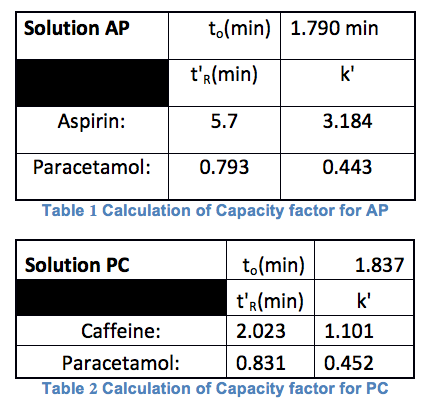Chromatogram Student Experiement
By: Ciaran Forde and Catherine Garbutt
ABSTRACT: All projects must be accompanied by an abstract. The abstract should briefly state the problem or purpose of the research, indicate the theoretical or experimental plan used, summarize the principal findings, and point out the major conclusions. Abstract length is one paragraph.
INTRODUCTION:
RESULTS & DISCUSSION: After analysis of the chromatograms obtained in the separation of solutions AP and PC we decided that the 70% pH 3.5 buffer with 30% methanol gave the best chromatogram. At this solvent composition there was good resolution of all peaks and a clear void peak, meaning that we can be certain that separation had actually occurred.
The capacity factors for Paracetamol and Aspirin in AP, and Caffeine and Paracetamol in PC were then calculated.

The capacity factors of the peaks in the Anadin (‘X’) solution were then calculated. These k’ values were then used to assign the peaks in the chromatogram. In the Anadin chromatogram peak 1 is Paracetamol, peak 2 is Caffeine, and peak 3 is Aspirin.
The width at half height for the Paracetamol and Caffeine peaks was then measured on screen within the HPLC software. As we analysed the X sample three times I have averaged the W1/2 measurements to reduce the error present in the values. The measured W1/2 values were then added to the formula for the resolution, Rs, which was calculated as 1.37. It is generally accepted that full baseline resolution is achieved when Rs≥1.5. as the calculated resolution is less than 1.5 the two peaks are not fully resolved under these solvent conditions.
